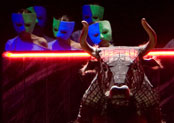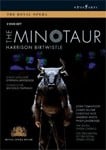OPERA SEARCH

The Minotaur
(2005-2007)Libretto by David Harsent (E)
Major roles: M,Bar,B; Subsidiary roles: 2S,CT,T,male speaker; Minor roles: 2S,M,2CT,speakers; chorus (SATB)
3(II,III=picc).3(III=corA).4(II=Eb,bcl;III=bcl;IV=bcl,dbcl).asax.3(III=dbn)-4.4.4(IV=contrabass tbn).2-timp(2 sets,on stage).perc(4):xyl/glsp/vib/crot/guiro/3tom-t(hi)/3tom-t(lo)/2BD(sm,lg)/2 log dr/tgl/4 wdbl/4 tpl.bl/2 bongos/2 conga dr/4 susp.cym/3 tam-t/2 nipple gongs(lg)-2harp.cimb-strings(14.12.10.8.7)
Abbreviations (PDF)
Boosey & Hawkes
Royal Opera House, London
John Tomlinson / Stephen Langridge, director / Alison Chitty, designer
Conductor: Antonio Pappano
Company: Royal Opera House
| ARIADNE | Mezzo-Soprano |
| THESEUS | Baritone |
| MINOTAUR 1 | Bass |
| MINOTAUR 2 (shadow of Minotaur 1) | speaking role |
| HIEREUS | Tenor |
| SNAKE PRIESTESS | Countertenor |
| KER 1 | Soprano |
| KERES | speaking roles |
| YOUNG WOMAN | Soprano |
| INNOCENTS | 2 Sopranos, Mezzo-Soprano, 2 Countertenors |
| CROWD | SATB chorus |
| 9-12 acrobats and dancers |
Crete, Minoan era
The Minotaur was the mythical beast, half-man, half-bull, imprisoned in the Labyrinth on the island of Crete. He was the offspring of Pasiphae, wife to King Minos: the result of her unnatural lust for the bull from the sea – sent by the god Poseidon at the request of Minos.
Athens is required each year to send young men and women for sacrifice to the Minotaur. This is an act of revenge for the death of Minos’s son at the hands of the Athenians. Theseus, putative son of Aegeus, king of Athens (though perhaps the son of Poseidon) offers to go to Crete on the occasion of one such sacrifice. His intention is to slay the Minotaur and thus cancel the debt.
At the start of the opera Ariadne, daughter of Minos and Pasiphae, greets the Innocents as they arrive from Athens. Among them is Theseus. She is attracted to him, but they are suspicious of each other’s motives. Ariadne is desperate to escape the prison of the island – the prison of her legacy – and sees in Theseus the possibility of escape.
In his dreams, the Minotaur – otherwise inarticulate – expresses the human side of his dual personality. In two symmetrical scenes, one in each half of the opera, he has visions of Ariadne, of his double, and of a shadowy figure (it is Theseus) who poses a threat to him, though he cannot understand what this is.
In a bloodthirsty but ritualised scene at the centre of the work, the sacrificial victims are caught and gored by the Minotaur. Keres, female death-spirits in the form of harpies, tear the hearts from the near-dead and feed on the bloody carcasses.
Ariadne attempts to persuade Theseus to take her with him back to Athens, but he refuses. She consults the Oracle in the hope of finding a way to ensure that, if Theseus is successful in his fight with the Minotaur, he will be able to find his way back out of the Labyrinth. She believes that, by acquiring this knowledge, she will achieve the kind of bargaining power to force him to do what she wants. The Oracle, speaking through the medium of a priest, or Hiereus, tells Ariadne to give Theseus a ball of twine that he can unwind as he goes through the Labyrinth and then follow back to safety. In answer to her insistent question, the Oracle also confirms to Ariadne that she and Theseus will set sail for Athens together, though this prophecy, while accurate, hints at Ariadne’s downfall.
The final section of the opera concerns the fight between Theseus and the Minotaur, and the latter’s death. As his life ebbs, the Minotaur acquires the power of human language: he describes the emptiness of his existence. As Ariadne and Theseus sail away, the Keres return and feed upon the body of the Minotaur, mirroring the end of the first half of the drama.
The gods look down and laugh …
David Harsent’s retelling of the myth of the Cretan Minotaur has a powerful slant: it considers the inner world of the Minotaur himself, and suggests a dark and compelling reason for Ariadne’s intense relationship with Theseus.
The Minotaur, imprisoned in the labyrinth, inhabits a narrow, pitiless world. He does not fully comprehend the duality of his physical nature as half-bull, half-man; only in sleep and, ultimately, in death does his human side become evident. Ariadne, too, is conscious of being imprisoned: she longs to escape from Crete, a place that serves only to remind her of an unbearable personal history in which her father’s hubris has been the cause of her mother’s sin against nature and the resultant birth of her monstrous half-brother.
Ariadne hopes that, with the help of the Oracle, she will enable Theseus to find a way out of the labyrinth should he survive his encounter with the Minotaur. She believes this will give her power over Theseus and persuade him to take her back with him to Athens. Both she and Theseus see the Minotaur as scapegoat and deliverance. In this cat’s-cradle of deviousness, cruelty, loss and betrayal, none is innocent, though none is wholly to blame.
Harsent’s haunting version brings an original interpretation to this well-known story.
“The most powerful and original opera yet to have emerged this century.” The Scotsman
“Blood-drenched and sorrowful, majestic and raw, The Minotaur plunders the extremes of human nature in music of coruscating, storming beauty… Low woodwind, sensuous strings and the spangly clatter of the cimbalom colour the orchestra in sombre, glistening tones. The rewards are at once unsettling and exhilarating… the applause, though deserved by all, was primarily for yet further proof of Birtwistle’s epic creative clarity.” Evening Standard
“…in the Minotaur himself, a role specially conceived for the bass John Tomlinson, Birtwistle has created one of his most complex and fascinating protagonists… It is a dramatic tour de force for Tomlinson, who handles it superbly and gives eloquence to a creature who can articulate his thoughts only in his dreams, and acquires the power of speech only after the fatal blow has landed.” The Guardian
“The moment when the beast stands revealed is a brilliant coup de théâtre. The drama is now both wonderful and dreadful; as more victims are raped and gored, blood upon blood, the crowd intones a drugged and ecstatic chorale brutally shattered by a screeching chorus of winged furies. Here the music’s crazy momentum displays Birtwistle’s talents at magnificently full stretch… the evening is a glittering success.” The Independent
“He is such a master of orchestration – he constantly takes the ear to new places, producing brilliant colours. And no one knows better how to build a tension, hold it, resolve it. There is hugely impressive writing for the slaughter of the innocents, shriek upon shriek cutting a swathe through the orchestra. Elsewhere, keening high brass over strings and low brass produces a mesmerizing effect. The work is broken by three orchestral toccatas, again with hauntingly beautiful material.” Opera America
“The music begins like flowing magma, muffled and dark, forming itself frequently à la Alban Berg into a lengthy adagio... A few times there is opportunity for excessive, indeed explosive visions of sound using the powerful range of percussion, particularly in depicting the murderous acts of the beast… Even the end of the Minotaur is dazzlingly reaffirmed in this manner… Compared with somewhat fussy myth adaptations such as Ulisse by Dallapiccola or some of Henze’s late works, Birtwistle demonstrates absolutely the hand of a heady, heavyweight storyteller-in-sound..” Frankfurter Rundschau
Dramatic, Poetic, Tragic

John Tomlinson / Johan Reuter / Christine Rice /
Andrew Watts / Philip Langridge / Amanda Echalaz /
Royal Opera House / Pappano / Stephen Langridge, dir
Opus Arte DVD 0A1000D
Click here to purchase a copy of this DVD from our online shop

